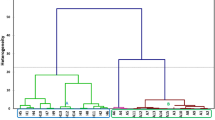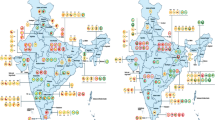Abstract
The current method for detection of Pseudomonas spp. count (PC) in chilled chicken involves cumbersome operations and a large amount of destruction, resulting in lower efficiency. Our study presents a fast non-destructive detection approach of PC in chilled chicken using hyperspectral imaging (HSI) system (329~1113 nm). The hyperspectral information of chilled chicken samples was collected, combined with the derivative method for spectral preprocessing, and then, a continuous projection algorithm was used to extract the characteristic wavelength. The partial least squares and AdaBoost-RT prediction regression models based on the characteristic and full-spectrum data were established respectively to study the quantitative relationship between the spectral information and chicken PC. The results showed that the second derivative pretreatment effect is relatively better. The best quantitative prediction model of PC in chicken samples was the AdaBoost-RT model based on the characteristic band (RP = 0.98, RMSEP = 0.27 (lg (CFU/g))). The overall study indicated that HSI technology (329~1113 nm) combined with the AdaBoost-RT algorithm could be used to detect the PC of chilled chicken in a rapid and non-destructive way.



Similar content being viewed by others
Data Availability
The relevant data are available from the corresponding author on request.
References
Achata E, Oliveira M, Esquerre C, Tiwarib B, O'Donnella C (2020) Visible and NIR hyperspectral imaging and chemometrics for prediction of microbial quality of beef longissimus dorsi muscle under simulated normal and abuse storage conditions. LWT 128:1–14. https://doi.org/10.1016/j.lwt.2020.109463
Araújo MCU, Saldanha TCB, Galvão RKH, Yoneyama T, Chame HC, Visani V (2001) The successive projections algorithm for variable selection in spectroscopic multicomponent analysis. Chemometr Intell Lab Syst 57:65–73. https://doi.org/10.1016/S0169-7439(01)00119-8
Bai X (2020) Processing and preservation of cold fresh meat. Modern Anim Husbandry Sci Tech 12:50–51
Feng Y-Z, Sun D-W (2013) Near-infrared hyperspectral imaging in tandem with partial least squares regression and genetic algorithm for non-destructive determination and visualization of Pseudomonas spp. loads in chicken fillets. Talanta 109(9):74–83. https://doi.org/10.1016/j.talanta.2013.01.057
He H-J, Wu D, Sun D-W (2014) Rapid and non-destructive determination of drip loss and pH distribution in farmed Atlantic salmon (Salmo salar) fillets using visible and near-infrared (Vis-NIR) hyperspectral imaging. Food Chem 156:394–401
He H-J, Sun D-W (2015) Toward enhancement in prediction of Pseudomonas spp. counts distribution in salmon fillets using NIR hyperspectral imaging. LWT-Food Science and Techno 62:11–18. https://doi.org/10.1016/j.lwt.2015.01.036
Huang L, Zhao J-W, Chen Q-S, Zhang Y-H (2013) Rapid detection of total viable count (TVC) in pork meat by hyperspectral imaging. Food Res Int 54(1):821–828. https://doi.org/10.1016/j.foodres.2013.08.011
Jia B-B, Yoon SC, Zhuang H, Wang W, Li C-Y (2017) Prediction of pH of fresh chicken breast fillets by VNIR hyperspectral imaging. J Food Eng 208:57–65. https://doi.org/10.1016/j.jfoodeng.2017.03.023
Koutsoumanis K, Giannakourou MC, Taoukis PS, Nychas GJE (2002) Application of shelf life decision system(SLDS) to marine cultured fish quality. Int J Food Microbiol 73:375–382. https://doi.org/10.1016/S0168-1605(01)00659-6
Li H-H, Kutsanedzie F, Zhao J-W, Chen Q-S (2016) Quantifying total viable count in pork meat using combined hyperspectral imaging and artificial olfaction techniques. Food Anal Methods 9(11):3015–3024. https://doi.org/10.1007/s12161-016-0475-9
Li Z-H, Yao K, Jia D-Y, Chi Y-L (2011) Isolation of predominant spoilage bacteria in chilled chicken breast and evaluation of the shelf life at low storage temperatures. Food Ferment Indus 37(1):167–170
Luo F-F, Li Z, Dai G, Lu Y-Q, He P-G, Wang Q-J (2020) Simultaneous detection of different bacteria by microchip electrophoresis combined with universal primer-duplex polymerase chain reaction. J Chromatogr A 1615:460734. https://doi.org/10.1016/j.chroma.2019.460734
McMeekin TA, Ross T (2002) Predictive microbiology: providing a knowledge-based framework for change management. Int J Food Microbiol 78:133–153. https://doi.org/10.1016/S0168-1605(02)00231-3
Ripolles-Avila C, Martínez-Garcia M, Capellas M, Yuste J, DYC F, Rodríguez-Jerez JJ (2020) From hazard analysis to risk control using rapid methods in microbiology: a practical approach for the food industry. Compr Rev Food Sci Food Saf 19(4):1877–1907. https://doi.org/10.1111/1541-4337.12592
Shi J-Y, Zhang F, Wu S-B, Guo Z-M, Huang X-W, Hu X-T, Holmes M, Zou X-B (2019) Noise-free microbial colony counting method based on hyperspectral features of agar plates. Food Chem 274:925–932
Sun L-M (2018) Application of microbial detection technology in food inspection. Food Safety Guide 21:65–65
Tang X-Y, Sun X-H, Wu VCH, Xie J, Pan Y-J, Zhao Y, Malakar PK (2013) Predicting shelf-life of chilled pork sold in China. Food Control 32(1):334–340. https://doi.org/10.1016/j.foodcont.2012.12.010
Thomas CJ, Mceekin A (1980) Contamination of broiler carcass skin during commercial processing procedures: an electron microscopic study. Appl Environ Microbiol 40:133–144
Wang J, Xue W, Shi X-J, Xu Y-C, Dong C-X (2021a) Adaboost-based machine learning improved the modeling robust and estimation accuracy of pear leaf nitrogen concentration by in-field VIS-NIR spectroscopy. Sensors (Basel) 21(18):6260. https://doi.org/10.3390/s21186260
Wang W-W, Zhao D-B, Xiang Q-S, Li K, Wang B-H, Bai Y-H (2021b) Effect of cinnamon essential oil nanoemulsions on microbiological safety and quality properties of chicken breast fillets during refrigerated storage. LWT 152:112376. https://doi.org/10.1016/j.lwt.2021.112376
Wang X-N (2020) Study on the detection of spoilage microorganisms in dairy products and the pollution ways. Food Safety Guide 15:51
Wang Z-L, Cai R, Gao Z-P, Yuan Y-H, Yue T-L (2020) Immunomagnetic separation: an effective pretreatment technology for isolation and enrichment in food microorganisms detection. Compr Rev Food Sci Food Saf 19(6):3802–3824. https://doi.org/10.1111/1541-4337.12656
Zhang B (2017) Microbial investigation and application of modified atmosphere preservation technology in the processing and storage of chilled chicken. Yangzhou University, Yangzhou
Zhao N, Liu Q, Sun K, Wang Y, Pan L-Q, Tu K, Zhang W (2019) Rapid prediction of total viable count of bacteria in liquid egg by hyperspectral imaging technology. Food Sci 40(8):262–269
Zhuang Q-B, Zheng X-C, Yang D-Y, Peng Y-K (2021) Comparative analysis of pork freshness and spoilage based on hyperspectral reflection characteristics Food. Science 42(16):254–260
Funding
This work was supported by the National key R & D plan (key project of intergovernmental international scientific and technological innovation cooperation, Grant No. 2019YFE0103800); Shanghai Agriculture Applied Technology Development Program, China (Grant No. X2021-02-08-00-12-F00782); and Science and Technology Commission of Shanghai Municipality (Grant No. 19430750600). The work also was supported by the Open Funding Project of State Key Laboratory of Microbial Metabolism (Grant No. MMLKF21-11).
Author information
Authors and Affiliations
Contributions
D.L. and Q.D. supervised the research. J.Z. performed all experiments and designed all Figures. Q.D. established the quantitative prediction model and performed the formal analysis. J.Z. and A.M. wrote the original draft. All authors reviewed the manuscript.
Corresponding author
Ethics declarations
Ethical Approval
Not applicable.
Informed Consent
Not applicable.
Conflict of Interest
Jiexiu Zhao declares that he has no competing interests. Aamir Mehmood declares that he has no competing interests. Qingli Dong declares that he has no competing interests. Daixi Li declares that he has no competing interests.
Additional information
Publisher’s Note
Springer Nature remains neutral with regard to jurisdictional claims in published maps and institutional affiliations.
Rights and permissions
Springer Nature or its licensor (e.g. a society or other partner) holds exclusive rights to this article under a publishing agreement with the author(s) or other rightsholder(s); author self-archiving of the accepted manuscript version of this article is solely governed by the terms of such publishing agreement and applicable law.
About this article
Cite this article
Zhao, J., Mehmood, A., Dong, Q. et al. Rapid Assessment of Chilled Chicken Spoilage Based on Hyperspectral Imaging Technology and AdaBoost-RT. Food Anal. Methods 16, 1504–1511 (2023). https://doi.org/10.1007/s12161-023-02501-9
Received:
Accepted:
Published:
Issue Date:
DOI: https://doi.org/10.1007/s12161-023-02501-9




